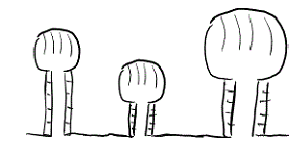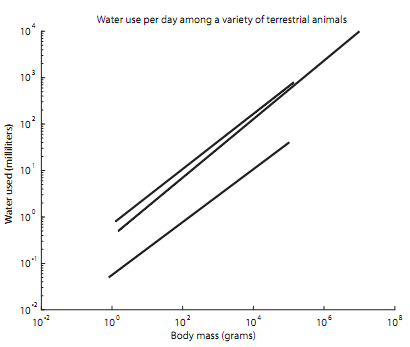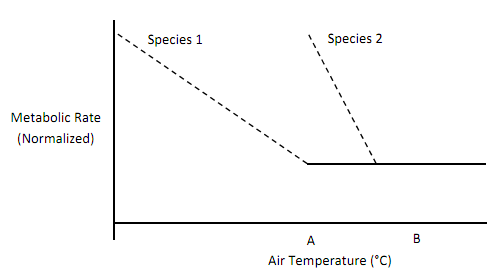Reference no: EM13743816
1) ______ The amount of heat produced for each liter of oxygen used in metabolism of fat is (a. much greater than; b. much less than; c. approximately equal to) the amount of heat produced for each liter of oxygen used in the metabolism of protein.
2) ______ The energy derived from the oxidation of 1 gram of carbohydrate is (a. greater than; b. less than; c. equal to) the energy derived from the oxidation of 1 gram of fat.
3) ______ The isocaloric weight of fat is (a. greater than; b. less than; c. equal to) that of glycogen.
4) ______ The myoglobin concentration in the muscle of aquatic mammals is generally (a. greater than; b. less than; c. equal to) that of the terrestrial mammals.
5) ______ Marine mammals such as sea lions probably meet most of their water requirements by (a. drinking sea water; b. from their food; c. from metabolism of fat & carbohydrate).
6) ______ The activity of the contractile vacuoles in a sponge placed in mildly brackish water is likely to (a. increase; b. stay the same; c. decrease) when compared to the same sponge in fresh water.
7) ______ The amount of oxygen dissolved in the body water of deep-diving marine mammals would be expected to be (a. greater than; b. less than; c. approximately equal to) that of terrestrial mammals.
8) ______ Suppose that a killer whale that was at rest in cold water begins swimming rapidly in pursuit of yummy seal snacks. You predict that the blood flow though the countercurrent heat exchanger in the blood supply to the flukes would (a. increase; b. decrease; c. remain unchanged).
9) ______ You compare the water loss rates of the similar size animals from the Sonoran desert - which of them will require the least amount of water per 100g of body mass? (a. gila monster [a reptile]; b. roadrunner [a bird]; c. kangaroo rat [a mammal])
10) ______ The actual oxygen debt accrued during the dive of a diving marine mammal is (a. greater than; b. less than; c. equal to) the predicted oxygen debt (based on normal metabolic rate).
11) ______ The endurance time for a large mammal is (a. greater than; b. less than; c. equal to) that of a small mammal.
12) ______ The absorptivity of an object is (a. greater than; b. less than; c. equal to) its emissivity at a given wavelength.
13) ______ The temperature of the skin surface (i.e., at the base of the fur) of a raccoon in cold air is (a. warmer than; b. cooler than; c. approximately the same as) the ambient air temperature.
14) ______ The temperature of the skin surface of a whale that is attempting to conserve heat in cold water is (a. warmer than; b. cooler than; c. approximately the same as) the ambient water temperature.
15) ______ Suppose that the ambient temperature is higher than the body temperature, and the body temperature of a mammal is constant. All heat loss must occur by (a. conduction; b. radiation; c. evaporation).
16) ______ You measure the urine production of a fish in its natural habitat and find that it produced almost 10% of its body weight in urine over the course of a day. This fish is probably a (a. marine teleost; b. coelacanth; c. freshwater teleost).
17) ______ The osmotic work required to maintain ion concentrations in freshwater invertebrates amounts to (a. less than 5%; b. between 5 and 10%; c. more than 10%) of basal metabolic rate for these animals.
18) ______ Marine iguanas eliminate excess ions via (a. their urine; b. specialized salt glands; c. their gills).
19) ______ The skin of a marine teleost (a. has hormonally controlled permeability; b. is impermeable; c. is permeable) to Cl-ions.
20) ______ Suppose we were to compare the cost of locomotion (kcal kg-1 km-1) for a tuna, an eagle, and a raccoon (all the same body mass). The cost of locomotion would be highest in the (a. tuna; b. eagle; c. raccoon).
21) ______ The thin waxy layer on the cuticle of most terrestrial insects affects the evaporation rate equation by changing the value of (a. K; b. J; c. WVPs)?
22) ______ Which of these groups of animals has solved the biggest water balance problem facing terrestrial animals (a. earthworms; b. slugs; c. snails)?
23) ______ Animals meeting their caloric and water needs metabolically should (a. metabolize only fat; b. metabolize only carbohydrate; c. metabolize fat or carbohydrate).
24) ______ The cost of running (kcal kg-1 km-1) for a deer would be (a. greater than; b. less than; c. equal to) that for a small dog.
25) ______ You collect a marine invertebrate from the brackish water of a tide pool and inject inulin into its body. You later collect urine from the animal and find that inulin is present in the urine. You conclude that the animal must use (a. active transport; b. ion excretion; c. ultrafiltration) as part of its excretory process.
26) ______ When osmoconforming following a transition from sea water to brackish water, the concentration of serine in the body fluids of a marine invertebrate is likely to (a. decrease; b. increase; c. stay the same).
Fill in the blank:
27) If the Q10 of a physiological process is 4, then an increase in temperature from 15°C to 45°C will cause the rate of the process to increase by a factor of ______________________________.
28) Some desert mammals use _______________________________ heat exchangers to cool the air leaving their lungs.
29 & 30) After acclimation to a higher temperature, a fish species shows an oxygen consumption that is equal to that observed at the lower temperature. This is called _________________________________. A related species, however, shows an oxygen consumption after acclimation at the higher temperature that is greater than that at the lower temperature but less than that predicted by the Q10. This is called _______________________________________.
31) The body fluids of a typical marine invertebrate living in its natural environment will have an osmolarity of approximately ___________________________ mOsm.
32) & 33) Animals living in the absence of oxygen obtain energy through the process of glycolysis, which involves the breakdown of _______________________________________ into ________________________________.
34) If the reflectivity of the fur of an animal is 36% of incident radiation at a particular wavelength, its absorptivity is ______% of the incident radiation at that wavelength.
35) Many freeze-susceptible insects have a compound in their blood called _________________________________ that lowers the freezing point and the supercooling point.
36) Deep diving marine mammals often have smaller relative lung volumes compared with terrestrial mammals. In addition, they are observed to exhale immediately before the dive. Why might this be so? _____________________________________________________________
37) The _______________________________________is the temperature range within which metabolic heat production is unaffected by temperature change.
38) Unlike most other vertebrates, elasmobranchs can tolerate high levels of ________________ in their body fluids, helping them achieve their slightly hyperosmotic state.
39) You measure the Na+ ion concentration in the body fluids of a shore crab and find that it is slightly less than that of sea water. This could be due to active regulation of Na+ or due to a ______________ equilibrium between Na+ and charged proteins in the crab.
40) Marine teleosts use __________________ cells in their gills to help maintain their hypoionic state.
41) Insects remove water from their urine in the rectum by establishing a local ___________________ gradient.
42) & 43) The osmolarity of body fluids is usually measured via _________________________ reduction and/or ___________________________ depression, changes to the physical properties of a solution brought about by the concentration of dissolved solutes.
Figure based questions:

44) Circle the protonephridia which is most appropriate for a fresh water animal.
45) Indicate the region on the right-most protonephridia which is permeable to water.
46) Label the lines for birds, mammals and reptiles on this graph of water use per day for animals of different body sizes. The lines do include the entire size range for each group.


A plot of metabolic rate (normalized) versus ambient temperature for two mammalian species is shown above. One species is tropical and the other lives in the Antarctic
47) Species __________ is tropical.
48) The temperature indicated by "A" is equal to the __________________ for species 1.
49) The slope of the plots is a measure of the _______________________________.
50) The temperature indicated by "B" is equal to the ___________________________.